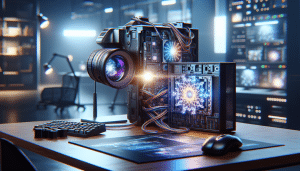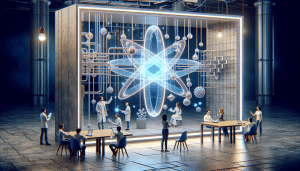Unlocking the Power of Artificial Intelligence in Daily Life
Aiden Foster September 1, 2025
Discover how artificial intelligence is shaping daily routines, transforming industries, and quietly enhancing your interactions with smart devices. Explore practical insights into the world of machine learning, neural networks, and ethical AI—revealing what makes this technology both fascinating and relevant.
The Rise of Artificial Intelligence in Modern Society
Artificial intelligence is no longer a futuristic concept found only in science fiction. Today, AI algorithms are woven into the fabric of daily life, driving technological innovations across sectors. From personal digital assistants to retail recommendations, machine learning models classify, predict, and even make decisions that shape human experiences. These tools analyze immense quantities of data, enabling tasks to be optimized and customized with unprecedented accuracy. As AI continues to advance, its influence grows stronger, intersecting with fields like medical diagnostics, autonomous vehicles, and financial services.
Many organizations turn to neural networks and deep learning systems to solve complex challenges. These AI-powered tools learn from vast datasets, refining their responses over time. For instance, in e-commerce, systems leverage AI to predict consumer trends and personalize online shopping journeys. In healthcare, machine learning supports early disease detection, analyzing medical images and patient records at remarkable speed. Even agriculture now benefits from artificial intelligence, monitoring crops and predicting yields more precisely than ever before. The reach of AI is extensive, touching daily life in ways that are often invisible yet impactful.
Understanding AI’s rapid adoption requires a look at the critical factors fueling growth. Cloud computing infrastructure, increased computational power, and open access to training datasets have all contributed to mainstream AI use. Furthermore, investment in research and collaborative innovation allows even smaller businesses to participate in the AI revolution. The implications? Everyday actions—sending emails, unlocking phones, or streaming music—are already shaped by AI, making it a quiet but powerful force in society’s evolution.
Machine Learning Drives New Directions for Technology
Machine learning represents a core subset of artificial intelligence where computers learn and adapt through data analysis. Instead of following strictly programmed rules, these systems infer patterns and improve outcomes with more experience. In finance, machine learning algorithms analyze market data to spot fraudulent behavior or automate trading decisions. In smart home gadgets, AI powers voice assistants, making device interactions more intuitive and helpful. These learning processes don’t stop after initial training—they continue to evolve with each new data input, reflecting real-world changes and user preferences.
Innovative applications of machine learning in education are revolutionizing classroom experiences. Adaptive learning platforms use AI to tailor assignments based on student progress, strengths, and areas for growth. Teachers gain access to detailed analytics, helping them support individuals more effectively. These tech-driven changes are not just theoretical—they significantly boost engagement and provide opportunities for personalized learning. At the same time, industries such as logistics and transportation utilize AI optimization techniques to route vehicles, manage inventory, and increase overall efficiency.
What truly sets machine learning apart is its versatility. Whether it’s powering language translation, medical research, or music recommendations, these AI models adapt across countless use cases. Training data is continually collected from interaction points—smartphones, websites, or connected devices—enabling systems to generate richer, more precise predictions. Machine learning is woven into the tech fabric of society, supporting seamless experiences for both businesses and consumers.
Smart Devices: Everyday AI and the Internet of Things
Most people interact with smart devices powered by artificial intelligence each day, often without realizing it. Voice-activated speakers, wearable fitness trackers, and home security cameras form an ecosystem known as the Internet of Things (IoT). These AI-enabled machines collect, process, and share information, making daily chores simpler and smarter. For example, a smart thermostat adjusts the temperature based on learned preferences, while fitness watches analyze physical activity and suggest improvements.
The integration of AI with IoT devices brings tangible benefits. Homeowners can automate lighting based on schedule or occupancy. Businesses gain insights from sensor data, optimizing energy use or preventive maintenance routines. Even cities leverage this AI-IoT synergy for ‘smart city’ initiatives—traffic monitoring, automated waste collection, and pollution controls—all designed to improve urban living and resource management. As AI capabilities advance, everyday tasks continue to grow more connected and responsive.
Security is a vital consideration in this landscape. AI helps protect smart devices from cyber threats by detecting anomalies in network activity and suggesting automated countermeasures. As the number of connected devices in homes and workplaces grows rapidly, robust cybersecurity powered by artificial intelligence becomes crucial. For users, AI translates to convenience, efficiency, and the promise of an interconnected future—all orchestrated by invisible algorithms working in the background.
Ethical Considerations and Responsible AI Development
The rise of powerful AI tools brings important ethical questions. Concerns about privacy, fairness, and transparency require careful attention. Data privacy, for instance, is an urgent issue as algorithms rely on massive stores of personal information. Ensuring proper consent, anonymization, and user control is central to responsible AI. Similarly, bias in machine learning models can perpetuate or even amplify existing inequalities if not diligently addressed by developers. Responsible design and governance foster trust and safeguard public interest.
Industry leaders and researchers emphasize the importance of transparency and accountability. Open-source frameworks, peer-reviewed evaluations, and public dialogue all contribute to more trustworthy AI systems. Regulatory bodies play a role, too, setting standards that balance innovation with safety. For example, in healthcare, AI-driven diagnoses undergo rigorous validation before real-world deployment. Ethical guidelines, often drafted in collaboration with universities and nonprofit organizations, help guide the responsible advancement of AI technologies.
Educating the public about how AI functions is essential. Transparency in algorithm design, explainable AI techniques, and routine audits help demystify artificial intelligence for users. This knowledge empowers individuals to make informed choices about their data and technology use. By championing ethical values, today’s AI community aims to ensure that technology offers lasting benefits to society—while minimizing harm and unintended consequences.
Future Trends: The Expanding Frontier of Artificial Intelligence
Anticipating the next phase of artificial intelligence reveals remarkable possibilities. Advances in deep learning, robotics, and natural language processing promise even greater integration of AI into work and leisure. In the near future, autonomous vehicles and drones could reshape transportation and delivery. AI-driven creativity, including art and music composition, continues to blur the boundary between human and machine ingenuity. These technologies stand ready to solve enormous challenges and spark new industries.
Even as AI capabilities surge forward, questions persist about the workforce and education. New job categories and skill sets are emerging, requiring adaptation and continuous learning. Experts recommend that institutions emphasize critical thinking, digital literacy, and ethical reasoning in curricula, ensuring individuals and communities are well equipped for an AI-enhanced era. Supporting inclusive growth is a shared goal among technology leaders, policymakers, and educators alike.
Finally, global collaboration and open innovation will define the AI landscape’s trajectory. Partnerships between governments, academia, and industry facilitate knowledge exchange and coordinated progress. Open databases, shared research tools, and cross-border projects accelerate breakthroughs—while ensuring AI advances remain accessible, safe, and beneficial for everyone. The journey into artificial intelligence’s expanding frontier is just beginning, with profound implications for society, science, and daily life.
References
1. National Institute of Standards and Technology. (n.d.). AI-Related Programs at NIST. Retrieved from https://www.nist.gov/artificial-intelligence
2. U.S. Food & Drug Administration. (n.d.). Artificial Intelligence and Machine Learning in Software as a Medical Device. Retrieved from https://www.fda.gov/medical-devices/software-medical-device-samd/artificial-intelligence-and-machine-learning-software-medical-device
3. Stanford University. (n.d.). Artificial Intelligence Index Report. Retrieved from https://aiindex.stanford.edu/report/
4. World Economic Forum. (n.d.). The Impact of AI on Society. Retrieved from https://www.weforum.org/agenda/archive/artificial-intelligence
5. European Commission. (n.d.). Ethics Guidelines for Trustworthy AI. Retrieved from https://ec.europa.eu/digital-single-market/en/news/ethics-guidelines-trustworthy-ai
6. National Institutes of Health. (n.d.). The Role of Artificial Intelligence in Healthcare. Retrieved from https://www.nih.gov/news-events/nih-research-matters/role-artificial-intelligence-healthcare








